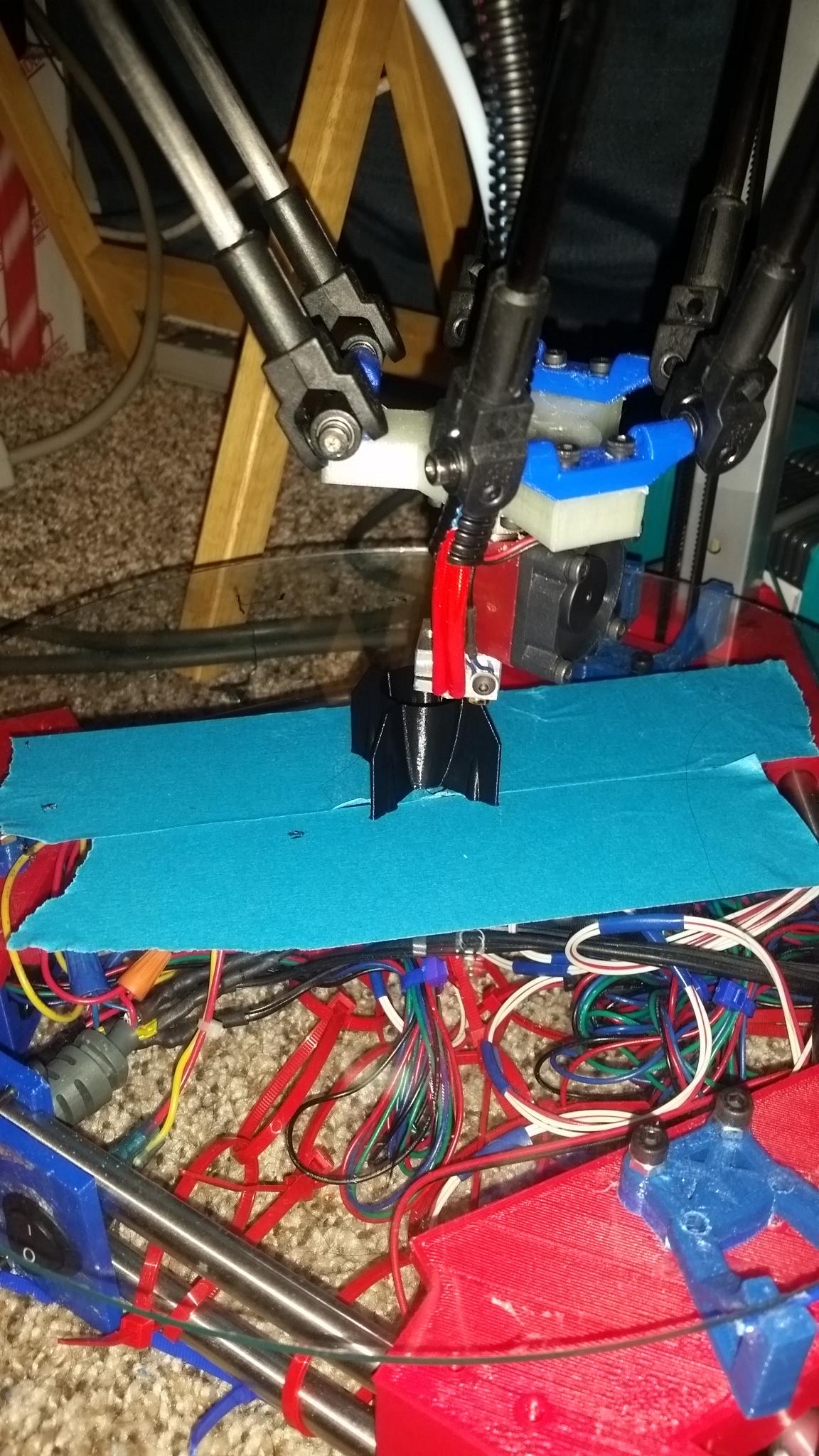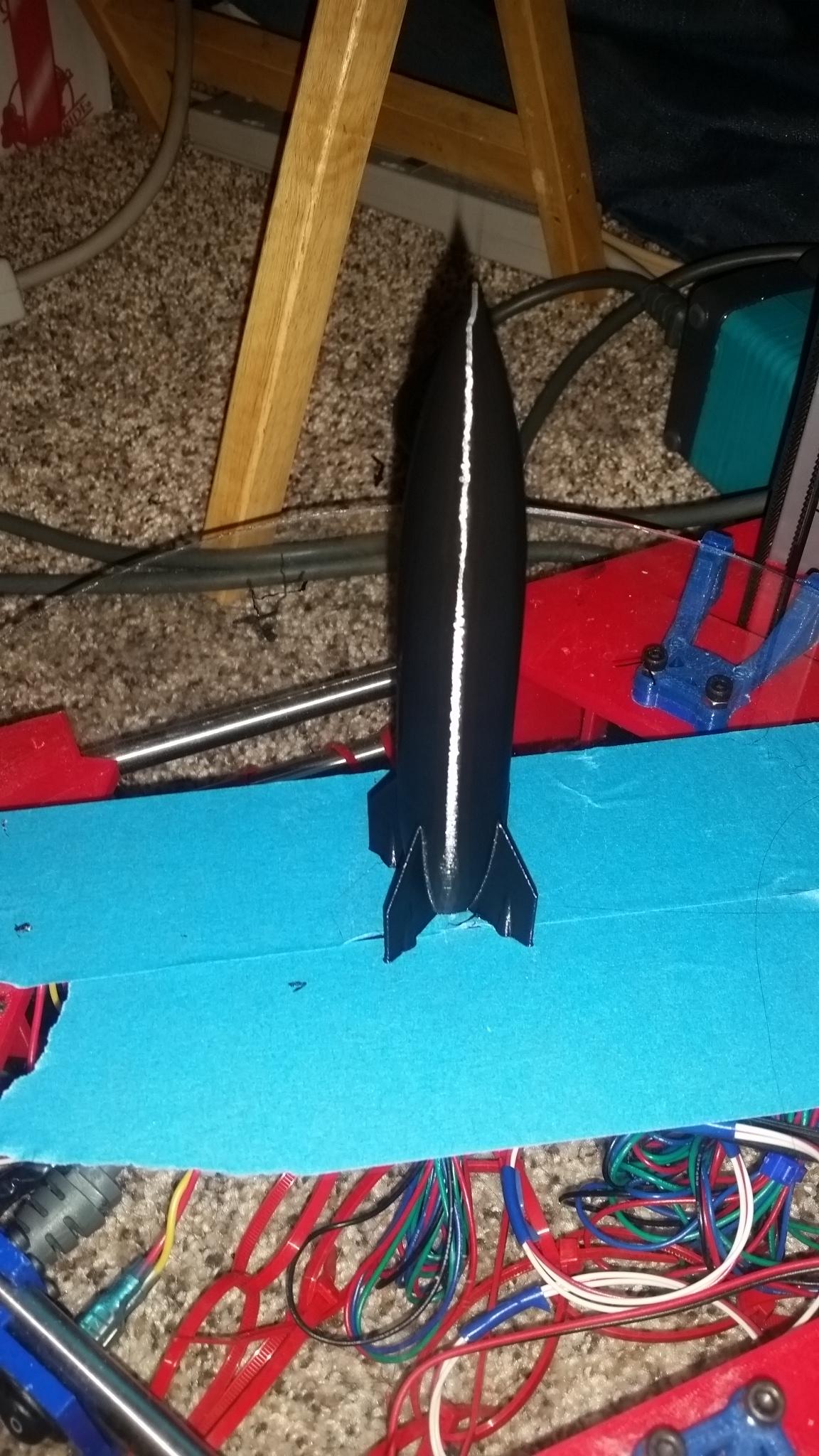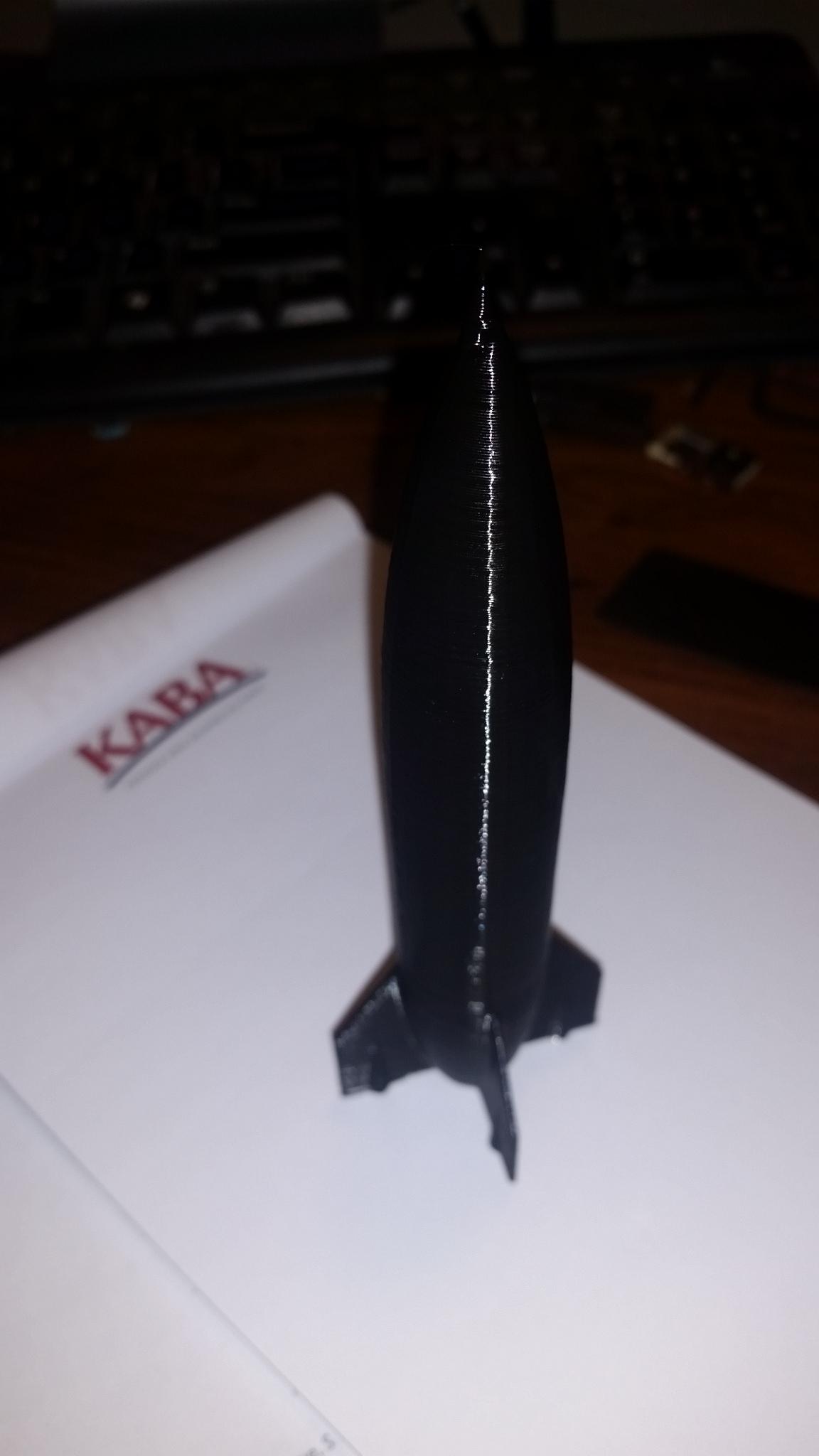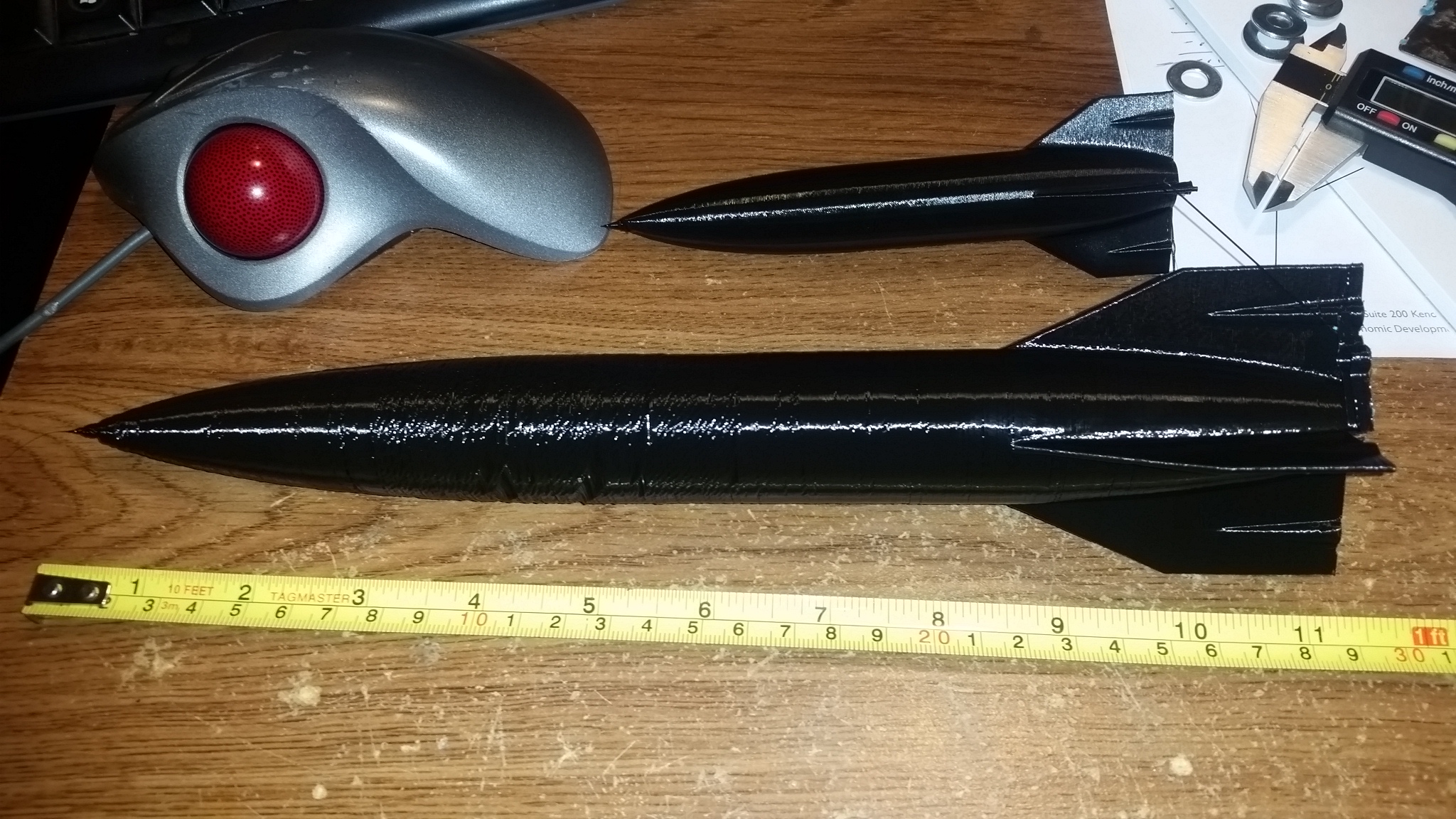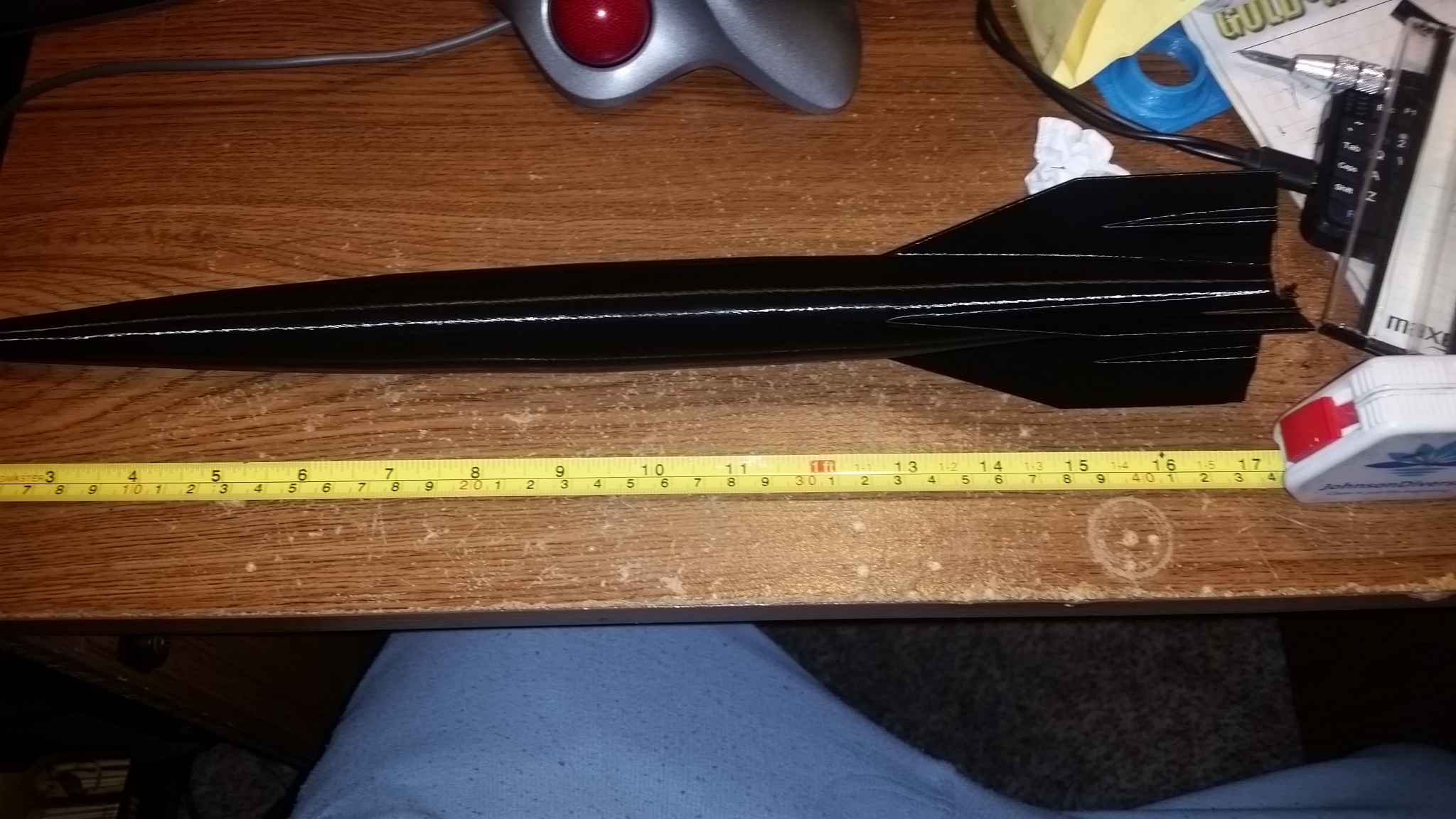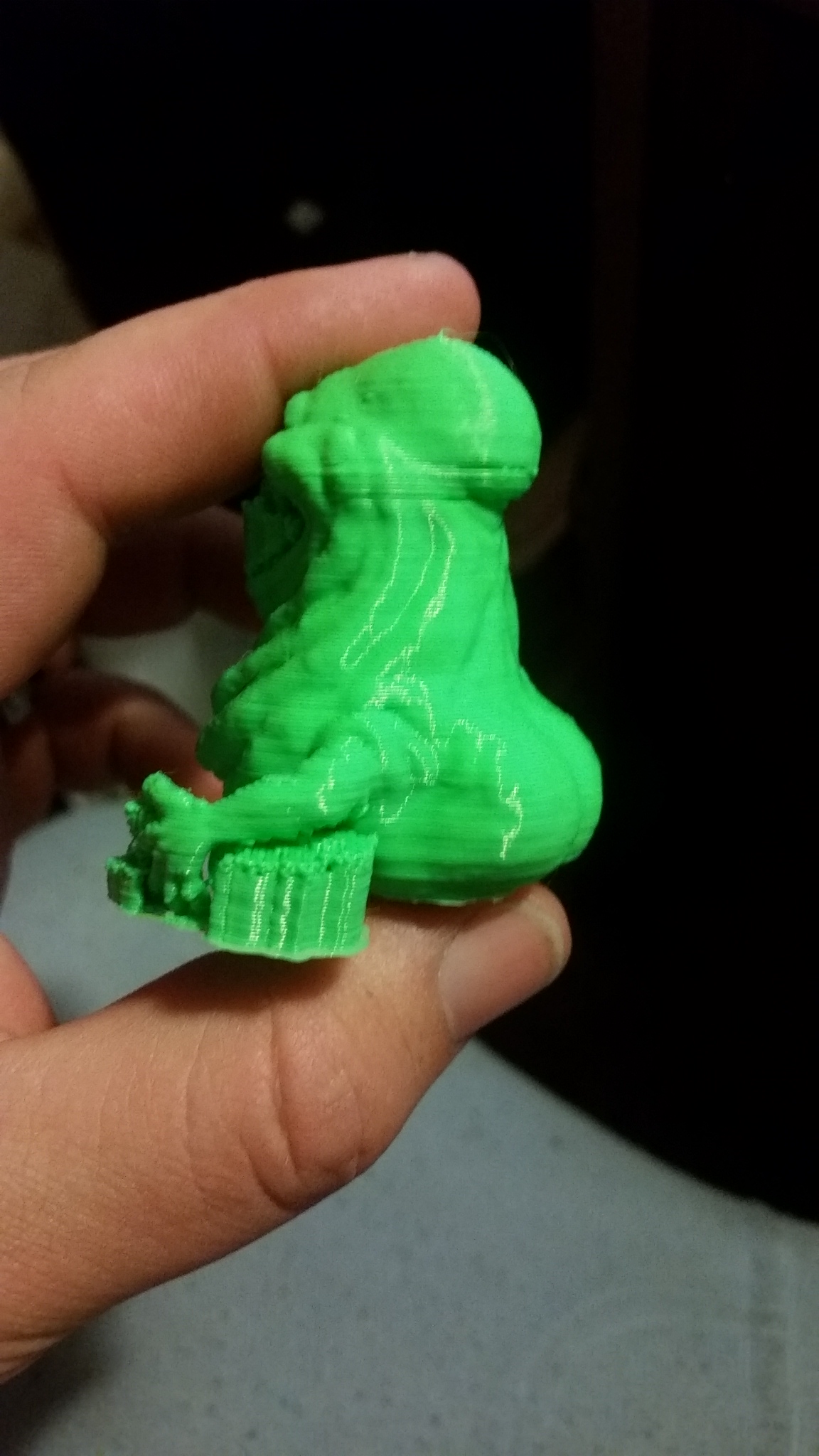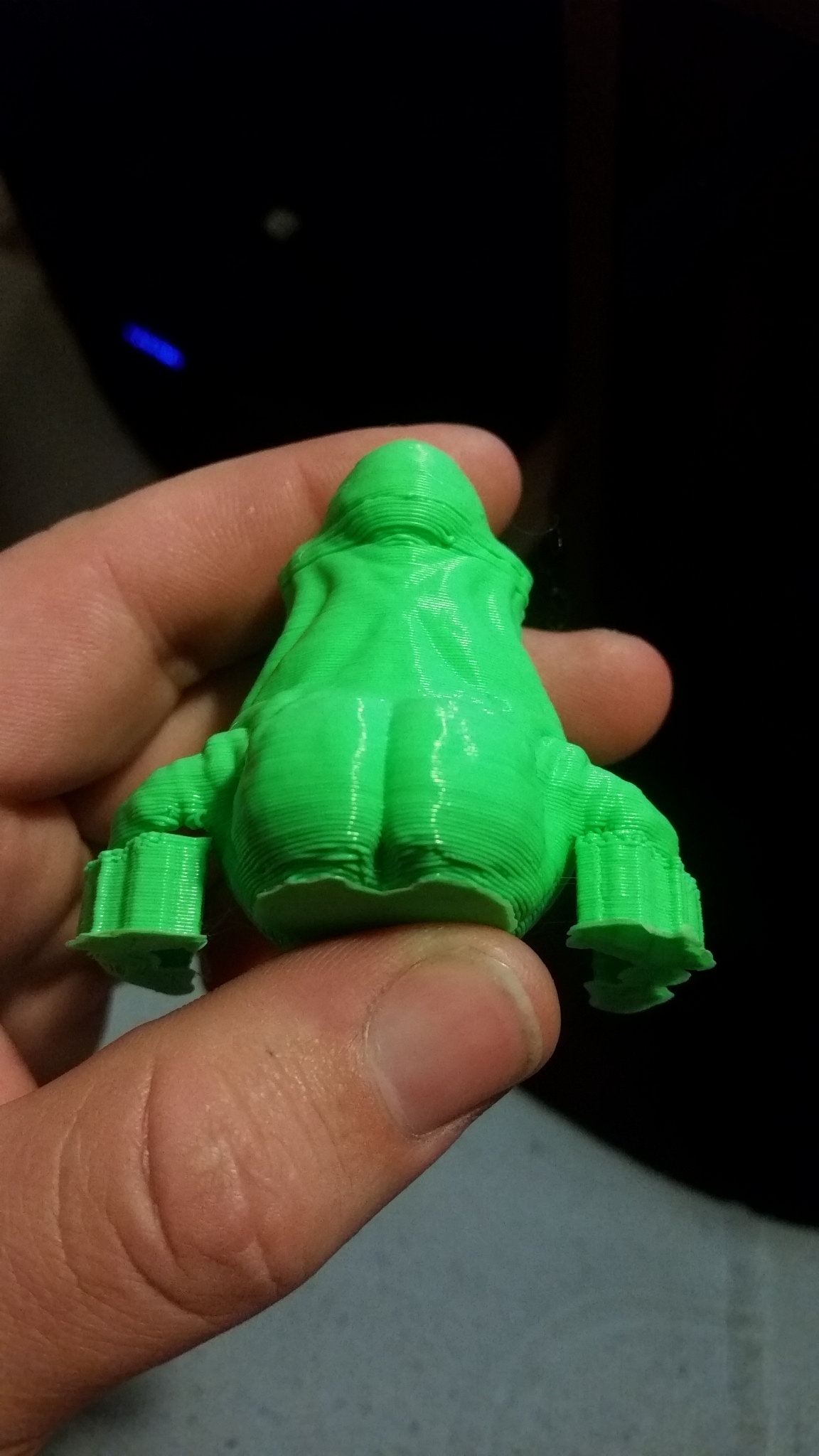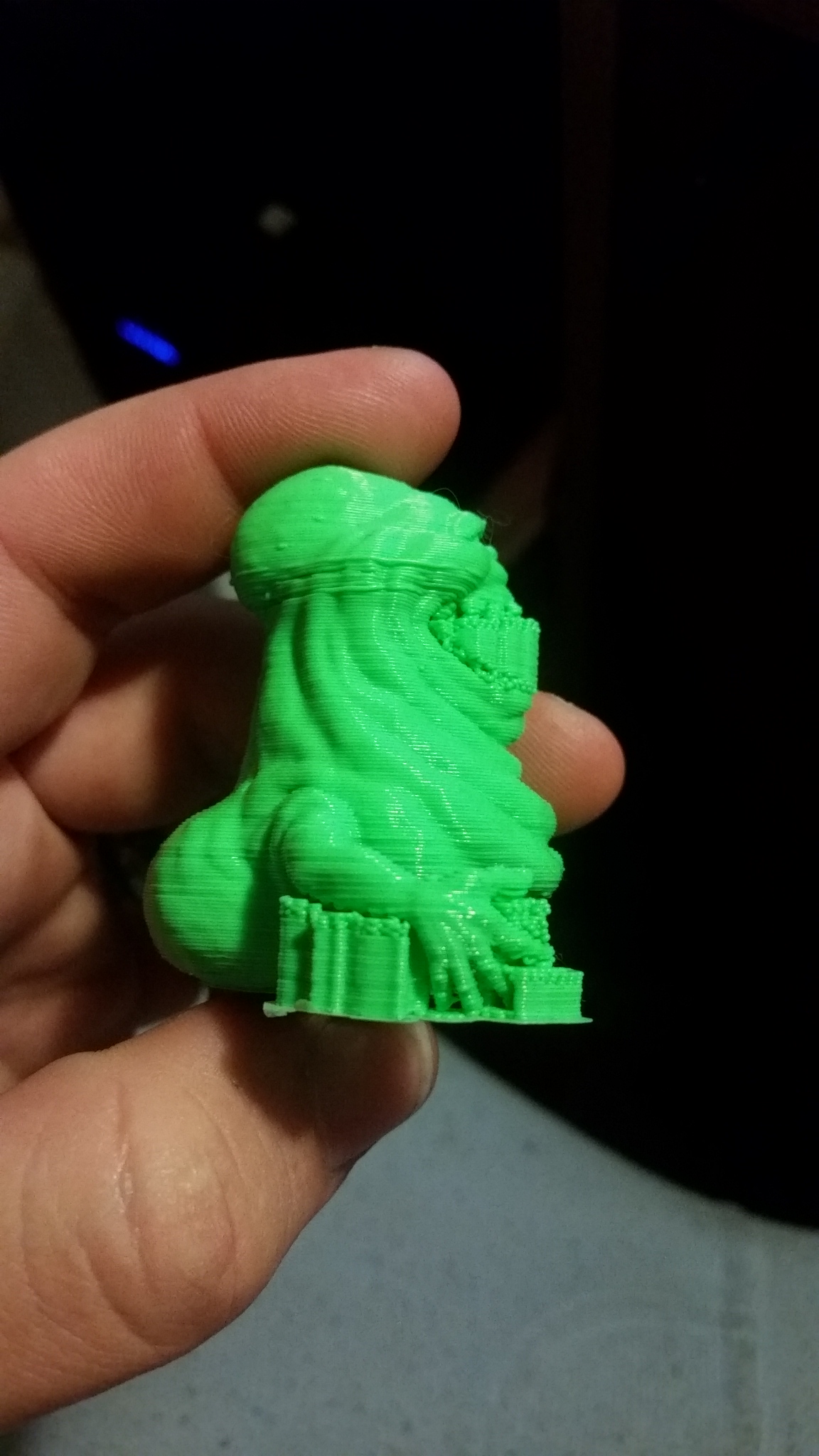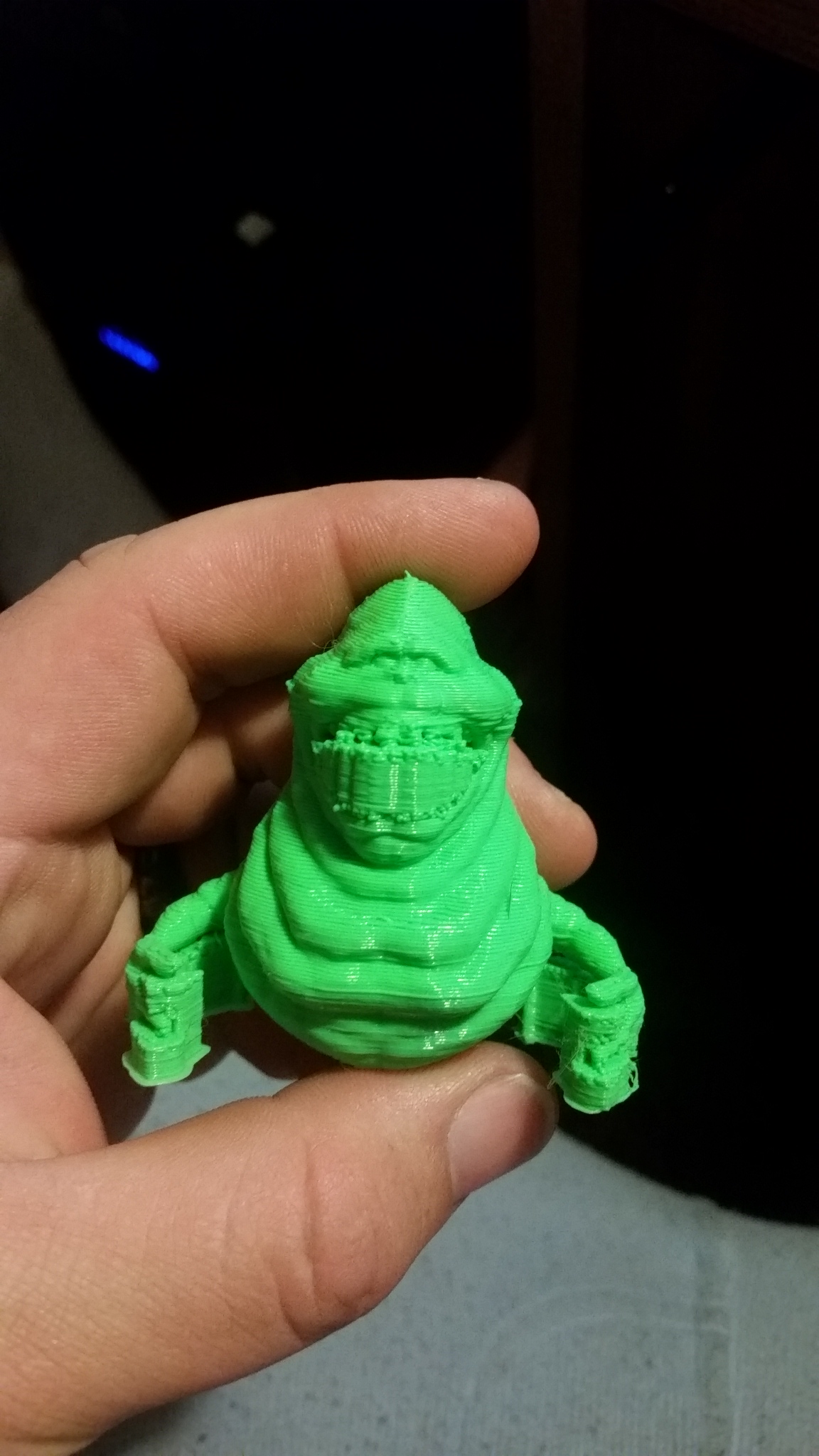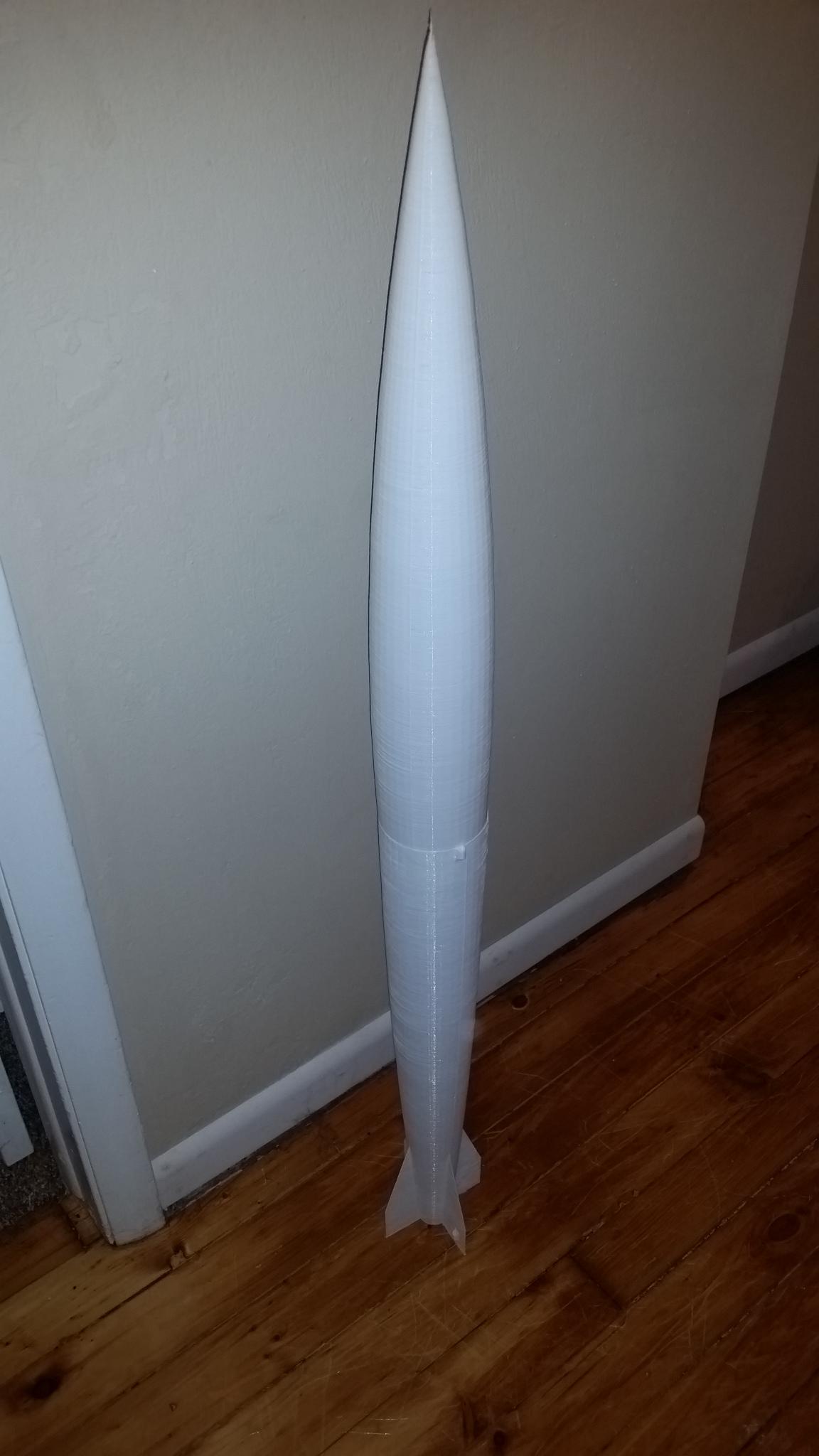Topic: My Delta Build 300mm x 610mm
Custom designed by me. check it out https://drive.google.com/file/d/0ByoUn6 … sp=sharing
Running marlin's delta build on a RAMPS 1.4 with Full graphic display
using 4 nema 17 motors 17HS13-0404S
Not even sure how many bolts lol
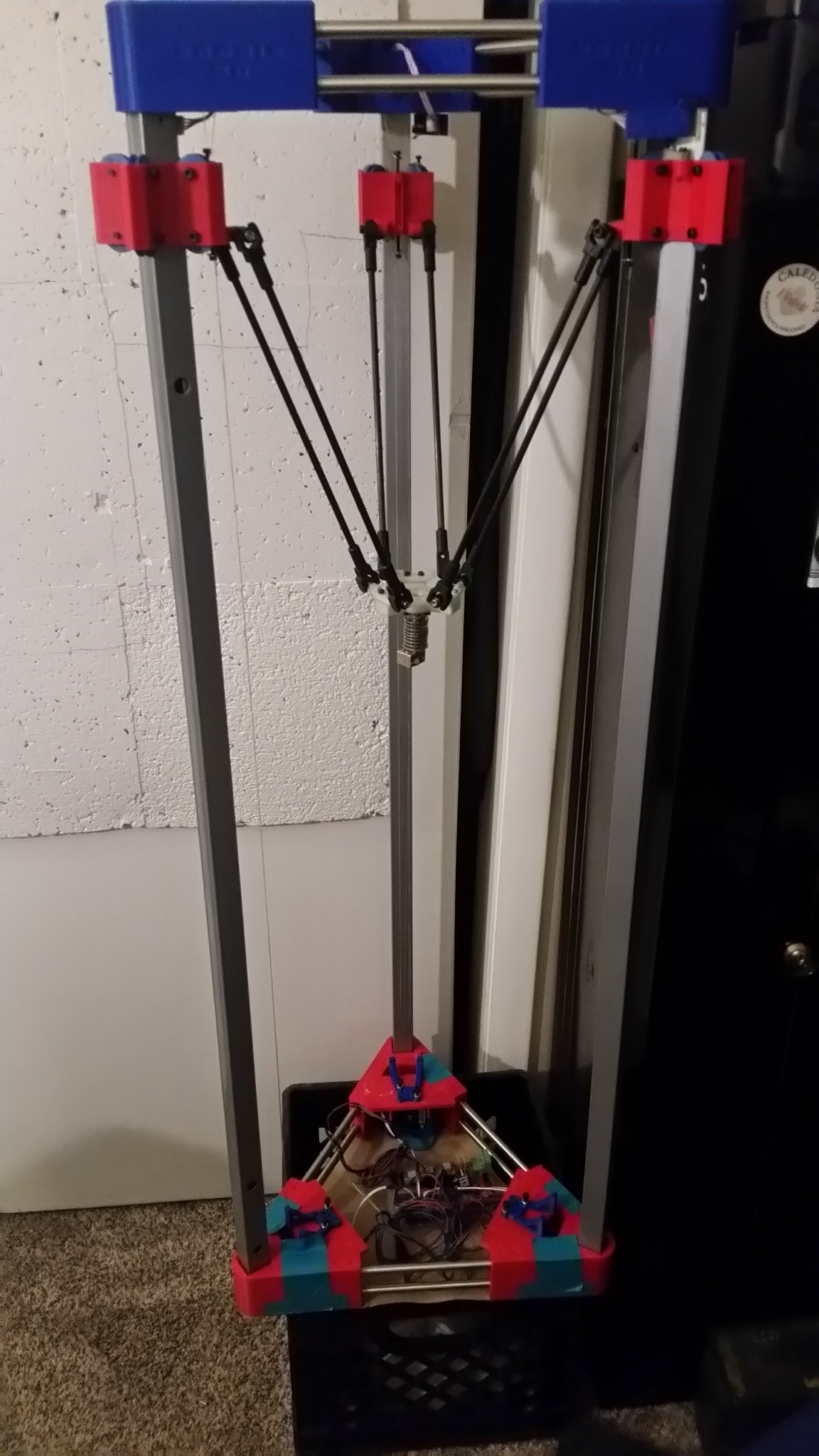
Current Problem:
Repetier max print height set to 500mm
When I manually home the machine, it moves like it should. On the first bump repeiter displays 500mm for Z height. But after it hits the second time it changes to 375mm. I cant seem to find any where else, like in the firmware, for max print height.
Video of whats happening.
Adding my config file
/**
* Marlin 3D Printer Firmware
* Copyright (C) 2016 MarlinFirmware [https://github.com/MarlinFirmware/Marlin]
*
* Based on Sprinter and grbl.
* Copyright (C) 2011 Camiel Gubbels / Erik van der Zalm
*
* This program is free software: you can redistribute it and/or modify
* it under the terms of the GNU General Public License as published by
* the Free Software Foundation, either version 3 of the License, or
* (at your option) any later version.
*
* This program is distributed in the hope that it will be useful,
* but WITHOUT ANY WARRANTY; without even the implied warranty of
* MERCHANTABILITY or FITNESS FOR A PARTICULAR PURPOSE. See the
* GNU General Public License for more details.
*
* You should have received a copy of the GNU General Public License
* along with this program. If not, see <http://www.gnu.org/licenses/>.
*
*/
/**
* Configuration.h
*
* Basic settings such as:
*
* - Type of electronics
* - Type of temperature sensor
* - Printer geometry
* - Endstop configuration
* - LCD controller
* - Extra features
*
* Advanced settings can be found in Configuration_adv.h
*
*/
#ifndef CONFIGURATION_H
#define CONFIGURATION_H
#include "boards.h"
#include "macros.h"
//===========================================================================
//============================= Getting Started =============================
//===========================================================================
/**
* Here are some standard links for getting your machine calibrated:
*
* http://reprap.org/wiki/Calibration
* http://youtu.be/wAL9d7FgInk
* http://calculator.josefprusa.cz
* http://reprap.org/wiki/Triffid_Hunter%27s_Calibration_Guide
* http://www.thingiverse.com/thing:5573
* https://sites.google.com/site/repraplogphase/calibration-of-your-reprap
* http://www.thingiverse.com/thing:298812
*/
//===========================================================================
//============================= DELTA Printer ===============================
//===========================================================================
// For a Delta printer replace the configuration files with the files in the
// example_configurations/delta directory.
//
//===========================================================================
//============================= SCARA Printer ===============================
//===========================================================================
// For a Scara printer replace the configuration files with the files in the
// example_configurations/SCARA directory.
//
// @section info
#if ENABLED(USE_AUTOMATIC_VERSIONING)
#include "_Version.h"
#else
#include "Version.h"
#endif
// User-specified version info of this build to display in [Pronterface, etc] terminal window during
// startup. Implementation of an idea by Prof Braino to inform user that any changes made to this
// build by the user have been successfully uploaded into firmware.
#define STRING_CONFIG_H_AUTHOR "(KronikAbuse, 8-17-2016)" // Who made the changes.
#define SHOW_BOOTSCREEN
#define STRING_SPLASH_LINE1 SHORT_BUILD_VERSION // will be shown during bootup in line 1
//#define STRING_SPLASH_LINE2 STRING_DISTRIBUTION_DATE // will be shown during bootup in line 2
// @section machine
// SERIAL_PORT selects which serial port should be used for communication with the host.
// This allows the connection of wireless adapters (for instance) to non-default port pins.
// Serial port 0 is still used by the Arduino bootloader regardless of this setting.
// :[0,1,2,3,4,5,6,7]
#define SERIAL_PORT 0
// This determines the communication speed of the printer
// :[2400,9600,19200,38400,57600,115200,250000]
#define BAUDRATE 250000
// Enable the Bluetooth serial interface on AT90USB devices
//#define BLUETOOTH
// The following define selects which electronics board you have.
// Please choose the name from boards.h that matches your setup
#ifndef MOTHERBOARD
#define MOTHERBOARD BOARD_RAMPS_14_EFB
#endif
// Optional custom name for your RepStrap or other custom machine
// Displayed in the LCD "Ready" message
#define CUSTOM_MACHINE_NAME "kronik bot"
// Define this to set a unique identifier for this printer, (Used by some programs to differentiate between machines)
// You can use an online service to generate a random UUID. (eg http://www.uuidgenerator.net/version4)
//#define MACHINE_UUID "00000000-0000-0000-0000-000000000000"
// This defines the number of extruders
// :[1,2,3,4]
#define EXTRUDERS 1
// Offset of the extruders (uncomment if using more than one and relying on firmware to position when changing).
// The offset has to be X=0, Y=0 for the extruder 0 hotend (default extruder).
// For the other hotends it is their distance from the extruder 0 hotend.
//#define EXTRUDER_OFFSET_X {0.0, 20.00} // (in mm) for each extruder, offset of the hotend on the X axis
//#define EXTRUDER_OFFSET_Y {0.0, 5.00} // (in mm) for each extruder, offset of the hotend on the Y axis
//// The following define selects which power supply you have. Please choose the one that matches your setup
// 1 = ATX
// 2 = X-Box 360 203Watts (the blue wire connected to PS_ON and the red wire to VCC)
// :{1:'ATX',2:'X-Box 360'}
#define POWER_SUPPLY 1
// Define this to have the electronics keep the power supply off on startup. If you don't know what this is leave it.
//#define PS_DEFAULT_OFF
// @section temperature
//===========================================================================
//============================= Thermal Settings ============================
//===========================================================================
//
//--NORMAL IS 4.7kohm PULLUP!-- 1kohm pullup can be used on hotend sensor, using correct resistor and table
//
//// Temperature sensor settings:
// -3 is thermocouple with MAX31855 (only for sensor 0)
// -2 is thermocouple with MAX6675 (only for sensor 0)
// -1 is thermocouple with AD595
// 0 is not used
// 1 is 100k thermistor - best choice for EPCOS 100k (4.7k pullup)
// 2 is 200k thermistor - ATC Semitec 204GT-2 (4.7k pullup)
// 3 is Mendel-parts thermistor (4.7k pullup)
// 4 is 10k thermistor !! do not use it for a hotend. It gives bad resolution at high temp. !!
// 5 is 100K thermistor - ATC Semitec 104GT-2 (Used in ParCan & J-Head) (4.7k pullup)
// 6 is 100k EPCOS - Not as accurate as table 1 (created using a fluke thermocouple) (4.7k pullup)
// 7 is 100k Honeywell thermistor 135-104LAG-J01 (4.7k pullup)
// 71 is 100k Honeywell thermistor 135-104LAF-J01 (4.7k pullup)
// 8 is 100k 0603 SMD Vishay NTCS0603E3104FXT (4.7k pullup)
// 9 is 100k GE Sensing AL03006-58.2K-97-G1 (4.7k pullup)
// 10 is 100k RS thermistor 198-961 (4.7k pullup)
// 11 is 100k beta 3950 1% thermistor (4.7k pullup)
// 12 is 100k 0603 SMD Vishay NTCS0603E3104FXT (4.7k pullup) (calibrated for Makibox hot bed)
// 13 is 100k Hisens 3950 1% up to 300°C for hotend "Simple ONE " & "Hotend "All In ONE"
// 20 is the PT100 circuit found in the Ultimainboard V2.x
// 60 is 100k Maker's Tool Works Kapton Bed Thermistor beta=3950
// 70 is the 100K thermistor found in the bq Hephestos 2
//
// 1k ohm pullup tables - This is not normal, you would have to have changed out your 4.7k for 1k
// (but gives greater accuracy and more stable PID)
// 51 is 100k thermistor - EPCOS (1k pullup)
// 52 is 200k thermistor - ATC Semitec 204GT-2 (1k pullup)
// 55 is 100k thermistor - ATC Semitec 104GT-2 (Used in ParCan & J-Head) (1k pullup)
//
// 1047 is Pt1000 with 4k7 pullup
// 1010 is Pt1000 with 1k pullup (non standard)
// 147 is Pt100 with 4k7 pullup
// 110 is Pt100 with 1k pullup (non standard)
// 998 and 999 are Dummy Tables. They will ALWAYS read 25°C or the temperature defined below.
// Use it for Testing or Development purposes. NEVER for production machine.
//#define DUMMY_THERMISTOR_998_VALUE 25
//#define DUMMY_THERMISTOR_999_VALUE 100
// :{ '0': "Not used", '4': "10k !! do not use for a hotend. Bad resolution at high temp. !!", '1': "100k / 4.7k - EPCOS", '51': "100k / 1k - EPCOS", '6': "100k / 4.7k EPCOS - Not as accurate as Table 1", '5': "100K / 4.7k - ATC Semitec 104GT-2 (Used in ParCan & J-Head)", '7': "100k / 4.7k Honeywell 135-104LAG-J01", '71': "100k / 4.7k Honeywell 135-104LAF-J01", '8': "100k / 4.7k 0603 SMD Vishay NTCS0603E3104FXT", '9': "100k / 4.7k GE Sensing AL03006-58.2K-97-G1", '10': "100k / 4.7k RS 198-961", '11': "100k / 4.7k beta 3950 1%", '12': "100k / 4.7k 0603 SMD Vishay NTCS0603E3104FXT (calibrated for Makibox hot bed)", '13': "100k Hisens 3950 1% up to 300°C for hotend 'Simple ONE ' & hotend 'All In ONE'", '60': "100k Maker's Tool Works Kapton Bed Thermistor beta=3950", '55': "100k / 1k - ATC Semitec 104GT-2 (Used in ParCan & J-Head)", '2': "200k / 4.7k - ATC Semitec 204GT-2", '52': "200k / 1k - ATC Semitec 204GT-2", '-3': "Thermocouple + MAX31855 (only for sensor 0)", '-2': "Thermocouple + MAX6675 (only for sensor 0)", '-1': "Thermocouple + AD595", '3': "Mendel-parts / 4.7k", '1047': "Pt1000 / 4.7k", '1010': "Pt1000 / 1k (non standard)", '20': "PT100 (Ultimainboard V2.x)", '147': "Pt100 / 4.7k", '110': "Pt100 / 1k (non-standard)", '998': "Dummy 1", '999': "Dummy 2" }
#define TEMP_SENSOR_0 998
#define TEMP_SENSOR_1 998
#define TEMP_SENSOR_2 0
#define TEMP_SENSOR_3 0
#define TEMP_SENSOR_BED 0
// This makes temp sensor 1 a redundant sensor for sensor 0. If the temperatures difference between these sensors is to high the print will be aborted.
//#define TEMP_SENSOR_1_AS_REDUNDANT
#define MAX_REDUNDANT_TEMP_SENSOR_DIFF 10
// Extruder temperature must be close to target for this long before M109 returns success
#define TEMP_RESIDENCY_TIME 10 // (seconds)
#define TEMP_HYSTERESIS 3 // (degC) range of +/- temperatures considered "close" to the target one
#define TEMP_WINDOW 1 // (degC) Window around target to start the residency timer x degC early.
// Bed temperature must be close to target for this long before M190 returns success
#define TEMP_BED_RESIDENCY_TIME 0 // (seconds)
#define TEMP_BED_HYSTERESIS 3 // (degC) range of +/- temperatures considered "close" to the target one
#define TEMP_BED_WINDOW 1 // (degC) Window around target to start the residency timer x degC early.
// The minimal temperature defines the temperature below which the heater will not be enabled It is used
// to check that the wiring to the thermistor is not broken.
// Otherwise this would lead to the heater being powered on all the time.
#define HEATER_0_MINTEMP 5
#define HEATER_1_MINTEMP 5
#define HEATER_2_MINTEMP 5
#define HEATER_3_MINTEMP 5
#define BED_MINTEMP 5
// When temperature exceeds max temp, your heater will be switched off.
// This feature exists to protect your hotend from overheating accidentally, but *NOT* from thermistor short/failure!
// You should use MINTEMP for thermistor short/failure protection.
#define HEATER_0_MAXTEMP 265
#define HEATER_1_MAXTEMP 265
#define HEATER_2_MAXTEMP 275
#define HEATER_3_MAXTEMP 275
#define BED_MAXTEMP 150
// If you want the M105 heater power reported in watts, define the BED_WATTS, and (shared for all extruders) EXTRUDER_WATTS
//#define EXTRUDER_WATTS (12.0*12.0/6.7) // P=U^2/R
//#define BED_WATTS (12.0*12.0/1.1) // P=U^2/R
//===========================================================================
//============================= PID Settings ================================
//===========================================================================
// PID Tuning Guide here: http://reprap.org/wiki/PID_Tuning
// Comment the following line to disable PID and enable bang-bang.
#define PIDTEMP
#define BANG_MAX 255 // limits current to nozzle while in bang-bang mode; 255=full current
#define PID_MAX BANG_MAX // limits current to nozzle while PID is active (see PID_FUNCTIONAL_RANGE below); 255=full current
#if ENABLED(PIDTEMP)
//#define PID_AUTOTUNE_MENU // Add PID Autotune to the LCD "Temperature" menu to run M303 and apply the result.
//#define PID_DEBUG // Sends debug data to the serial port.
//#define PID_OPENLOOP 1 // Puts PID in open loop. M104/M140 sets the output power from 0 to PID_MAX
//#define SLOW_PWM_HEATERS // PWM with very low frequency (roughly 0.125Hz=8s) and minimum state time of approximately 1s useful for heaters driven by a relay
//#define PID_PARAMS_PER_EXTRUDER // Uses separate PID parameters for each extruder (useful for mismatched extruders)
// Set/get with gcode: M301 E[extruder number, 0-2]
#define PID_FUNCTIONAL_RANGE 10 // If the temperature difference between the target temperature and the actual temperature
// is more than PID_FUNCTIONAL_RANGE then the PID will be shut off and the heater will be set to min/max.
#define PID_INTEGRAL_DRIVE_MAX PID_MAX //limit for the integral term
#define K1 0.95 //smoothing factor within the PID
// If you are using a pre-configured hotend then you can use one of the value sets by uncommenting it
// Ultimaker
#define DEFAULT_Kp 22.2
#define DEFAULT_Ki 1.08
#define DEFAULT_Kd 114
// MakerGear
//#define DEFAULT_Kp 7.0
//#define DEFAULT_Ki 0.1
//#define DEFAULT_Kd 12
// Mendel Parts V9 on 12V
//#define DEFAULT_Kp 63.0
//#define DEFAULT_Ki 2.25
//#define DEFAULT_Kd 440
#endif // PIDTEMP
//===========================================================================
//============================= PID > Bed Temperature Control ===============
//===========================================================================
// Select PID or bang-bang with PIDTEMPBED. If bang-bang, BED_LIMIT_SWITCHING will enable hysteresis
//
// Uncomment this to enable PID on the bed. It uses the same frequency PWM as the extruder.
// If your PID_dT is the default, and correct for your hardware/configuration, that means 7.689Hz,
// which is fine for driving a square wave into a resistive load and does not significantly impact you FET heating.
// This also works fine on a Fotek SSR-10DA Solid State Relay into a 250W heater.
// If your configuration is significantly different than this and you don't understand the issues involved, you probably
// shouldn't use bed PID until someone else verifies your hardware works.
// If this is enabled, find your own PID constants below.
//#define PIDTEMPBED
//#define BED_LIMIT_SWITCHING
// This sets the max power delivered to the bed, and replaces the HEATER_BED_DUTY_CYCLE_DIVIDER option.
// all forms of bed control obey this (PID, bang-bang, bang-bang with hysteresis)
// setting this to anything other than 255 enables a form of PWM to the bed just like HEATER_BED_DUTY_CYCLE_DIVIDER did,
// so you shouldn't use it unless you are OK with PWM on your bed. (see the comment on enabling PIDTEMPBED)
#define MAX_BED_POWER 255 // limits duty cycle to bed; 255=full current
#if ENABLED(PIDTEMPBED)
//#define PID_BED_DEBUG // Sends debug data to the serial port.
#define PID_BED_INTEGRAL_DRIVE_MAX MAX_BED_POWER //limit for the integral term
//120V 250W silicone heater into 4mm borosilicate (MendelMax 1.5+)
//from FOPDT model - kp=.39 Tp=405 Tdead=66, Tc set to 79.2, aggressive factor of .15 (vs .1, 1, 10)
#define DEFAULT_bedKp 10.00
#define DEFAULT_bedKi .023
#define DEFAULT_bedKd 305.4
//120V 250W silicone heater into 4mm borosilicate (MendelMax 1.5+)
//from pidautotune
//#define DEFAULT_bedKp 97.1
//#define DEFAULT_bedKi 1.41
//#define DEFAULT_bedKd 1675.16
// FIND YOUR OWN: "M303 E-1 C8 S90" to run autotune on the bed at 90 degreesC for 8 cycles.
#endif // PIDTEMPBED
// @section extruder
//this prevents dangerous Extruder moves, i.e. if the temperature is under the limit
//can be software-disabled for whatever purposes by
//#define PREVENT_DANGEROUS_EXTRUDE
//if PREVENT_DANGEROUS_EXTRUDE is on, you can still disable (uncomment) very long bits of extrusion separately.
#define PREVENT_LENGTHY_EXTRUDE
#define EXTRUDE_MINTEMP 170
#define EXTRUDE_MAXLENGTH (X_MAX_LENGTH+Y_MAX_LENGTH) //prevent extrusion of very large distances.
//===========================================================================
//======================== Thermal Runaway Protection =======================
//===========================================================================
/**
* Thermal Protection protects your printer from damage and fire if a
* thermistor falls out or temperature sensors fail in any way.
*
* The issue: If a thermistor falls out or a temperature sensor fails,
* Marlin can no longer sense the actual temperature. Since a disconnected
* thermistor reads as a low temperature, the firmware will keep the heater on.
*
* If you get "Thermal Runaway" or "Heating failed" errors the
* details can be tuned in Configuration_adv.h
*/
#define THERMAL_PROTECTION_HOTENDS // Enable thermal protection for all extruders
#define THERMAL_PROTECTION_BED // Enable thermal protection for the heated bed
//===========================================================================
//============================= Mechanical Settings =========================
//===========================================================================
// @section machine
// Uncomment this option to enable CoreXY kinematics
//#define COREXY
// Uncomment this option to enable CoreXZ kinematics
//#define COREXZ
//===========================================================================
//============================== Delta Settings =============================
//===========================================================================
// Enable DELTA kinematics and most of the default configuration for Deltas
#define DELTA
#if ENABLED(DELTA)
// Make delta curves from many straight lines (linear interpolation).
// This is a trade-off between visible corners (not enough segments)
// and processor overload (too many expensive sqrt calls).
#define DELTA_SEGMENTS_PER_SECOND 120
// NOTE NB all values for DELTA_* values MUST be floating point, so always have a decimal point in them
// Center-to-center distance of the holes in the diagonal push rods.
#define DELTA_DIAGONAL_ROD 300.0 // mm
// Horizontal offset from middle of printer to smooth rod center.
#define DELTA_SMOOTH_ROD_OFFSET 205.0 // mm
// Horizontal offset of the universal joints on the end effector.
#define DELTA_EFFECTOR_OFFSET 35.0 // mm
// Horizontal offset of the universal joints on the carriages.
#define DELTA_CARRIAGE_OFFSET 50.0 // mm
// Horizontal distance bridged by diagonal push rods when effector is centered.
#define DELTA_RADIUS (DELTA_SMOOTH_ROD_OFFSET-(DELTA_EFFECTOR_OFFSET)-(DELTA_CARRIAGE_OFFSET))
// Print surface diameter/2 minus unreachable space (avoid collisions with vertical towers).
#define DELTA_PRINTABLE_RADIUS 148.0
// Delta calibration menu
// uncomment to add three points calibration menu option.
// See http://minow.blogspot.com/index.html#4918805519571907051
// If needed, adjust the X, Y, Z calibration coordinates
// in ultralcd.cpp@lcd_delta_calibrate_menu()
#define DELTA_CALIBRATION_MENU
#endif
// Enable this option for Toshiba steppers
//#define CONFIG_STEPPERS_TOSHIBA
//===========================================================================
//============================== Endstop Settings ===========================
//===========================================================================
// @section homing
// Specify here all the endstop connectors that are connected to any endstop or probe.
// Almost all printers will be using one per axis. Probes will use one or more of the
// extra connectors. Leave undefined any used for non-endstop and non-probe purposes.
//#define USE_XMIN_PLUG
//#define USE_YMIN_PLUG
#define USE_ZMIN_PLUG // a Z probe
#define USE_XMAX_PLUG
#define USE_YMAX_PLUG
#define USE_ZMAX_PLUG
// coarse Endstop Settings
#define ENDSTOPPULLUPS // Comment this out (using // at the start of the line) to disable the endstop pullup resistors
#if DISABLED(ENDSTOPPULLUPS)
// fine endstop settings: Individual pullups. will be ignored if ENDSTOPPULLUPS is defined
//#define ENDSTOPPULLUP_XMAX
//#define ENDSTOPPULLUP_YMAX
//#define ENDSTOPPULLUP_ZMAX
//#define ENDSTOPPULLUP_XMIN
//#define ENDSTOPPULLUP_YMIN
//#define ENDSTOPPULLUP_ZMIN
//#define ENDSTOPPULLUP_ZMIN_PROBE
#endif
// Mechanical endstop with COM to ground and NC to Signal uses "false" here (most common setup).
const bool X_MIN_ENDSTOP_INVERTING = true; // set to true to invert the logic of the endstop.
const bool Y_MIN_ENDSTOP_INVERTING = true; // set to true to invert the logic of the endstop.
const bool Z_MIN_ENDSTOP_INVERTING = true; // set to true to invert the logic of the endstop.
const bool X_MAX_ENDSTOP_INVERTING = true; // set to true to invert the logic of the endstop.
const bool Y_MAX_ENDSTOP_INVERTING = true; // set to true to invert the logic of the endstop.
const bool Z_MAX_ENDSTOP_INVERTING = true; // set to true to invert the logic of the endstop.
const bool Z_MIN_PROBE_ENDSTOP_INVERTING = true; // set to true to invert the logic of the endstop.
//===========================================================================
//============================= Z Probe Options =============================
//===========================================================================
// Enable Z_MIN_PROBE_ENDSTOP to use _both_ a Z Probe and a Z-min-endstop on the same machine.
// With this option the Z_MIN_PROBE_PIN will only be used for probing, never for homing.
//
// *** PLEASE READ ALL INSTRUCTIONS BELOW FOR SAFETY! ***
//
// To continue using the Z-min-endstop for homing, be sure to disable Z_SAFE_HOMING.
// Example: To park the head outside the bed area when homing with G28.
//
// To use a separate Z probe, your board must define a Z_MIN_PROBE_PIN.
//
// For a servo-based Z probe, you must set up servo support below, including
// NUM_SERVOS, Z_ENDSTOP_SERVO_NR and SERVO_ENDSTOP_ANGLES.
//
// - RAMPS 1.3/1.4 boards may be able to use the 5V, GND, and Aux4->D32 pin.
// - Use 5V for powered (usu. inductive) sensors.
// - Otherwise connect:
// - normally-closed switches to GND and D32.
// - normally-open switches to 5V and D32.
//
// Normally-closed switches are advised and are the default.
//
// The Z_MIN_PROBE_PIN sets the Arduino pin to use. (See your board's pins file.)
// Since the RAMPS Aux4->D32 pin maps directly to the Arduino D32 pin, D32 is the
// default pin for all RAMPS-based boards. Some other boards map differently.
// To set or change the pin for your board, edit the appropriate pins_XXXXX.h file.
//
// WARNING:
// Setting the wrong pin may have unexpected and potentially disastrous consequences.
// Use with caution and do your homework.
//
#define Z_MIN_PROBE_ENDSTOP
// Enable Z_MIN_PROBE_USES_Z_MIN_ENDSTOP_PIN to use the Z_MIN_PIN for your Z_MIN_PROBE.
// The Z_MIN_PIN will then be used for both Z-homing and probing.
//#define Z_MIN_PROBE_USES_Z_MIN_ENDSTOP_PIN
// To use a probe you must enable one of the two options above!
// This option disables the use of the Z_MIN_PROBE_PIN
// To enable the Z probe pin but disable its use, uncomment the line below. This only affects a
// Z probe switch if you have a separate Z min endstop also and have activated Z_MIN_PROBE_ENDSTOP above.
// If you're using the Z MIN endstop connector for your Z probe, this has no effect.
//#define DISABLE_Z_MIN_PROBE_ENDSTOP
// For Inverting Stepper Enable Pins (Active Low) use 0, Non Inverting (Active High) use 1
// :{0:'Low',1:'High'}
#define X_ENABLE_ON 0
#define Y_ENABLE_ON 0
#define Z_ENABLE_ON 0
#define E_ENABLE_ON 0 // For all extruders
// Disables axis stepper immediately when it's not being used.
// WARNING: When motors turn off there is a chance of losing position accuracy!
#define DISABLE_X false
#define DISABLE_Y false
#define DISABLE_Z false
// Warn on display about possibly reduced accuracy
//#define DISABLE_REDUCED_ACCURACY_WARNING
// @section extruder
#define DISABLE_E false // For all extruders
#define DISABLE_INACTIVE_EXTRUDER true //disable only inactive extruders and keep active extruder enabled
// @section machine
// Invert the stepper direction. Change (or reverse the motor connector) if an axis goes the wrong way.
#define INVERT_X_DIR false // DELTA does not invert
#define INVERT_Y_DIR false
#define INVERT_Z_DIR false
// @section extruder
// For direct drive extruder v9 set to true, for geared extruder set to false.
#define INVERT_E0_DIR false
#define INVERT_E1_DIR false
#define INVERT_E2_DIR false
#define INVERT_E3_DIR false
// @section homing
//#define MIN_Z_HEIGHT_FOR_HOMING 4 // (in mm) Minimal z height before homing (G28) for Z clearance above the bed, clamps, ...
// Be sure you have this distance over your Z_MAX_POS in case.
// ENDSTOP SETTINGS:
// Sets direction of endstops when homing; 1=MAX, -1=MIN
// :[-1,1]
#define X_HOME_DIR 1 // deltas always home to max
#define Y_HOME_DIR 1
#define Z_HOME_DIR 1
#define min_software_endstops true // If true, axis won't move to coordinates less than HOME_POS.
#define max_software_endstops true // If true, axis won't move to coordinates greater than the defined lengths below.
// @section machine
// Travel limits after homing (units are in mm)
#define X_MIN_POS -(DELTA_PRINTABLE_RADIUS)
#define Y_MIN_POS -(DELTA_PRINTABLE_RADIUS)
#define Z_MIN_POS 0
#define X_MAX_POS DELTA_PRINTABLE_RADIUS
#define Y_MAX_POS DELTA_PRINTABLE_RADIUS
#define Z_MAX_POS MANUAL_Z_HOME_POS
//===========================================================================
//========================= Filament Runout Sensor ==========================
//===========================================================================
//#define FILAMENT_RUNOUT_SENSOR // Uncomment for defining a filament runout sensor such as a mechanical or opto endstop to check the existence of filament
// In RAMPS uses servo pin 2. Can be changed in pins file. For other boards pin definition should be made.
// It is assumed that when logic high = filament available
// when logic low = filament ran out
#if ENABLED(FILAMENT_RUNOUT_SENSOR)
const bool FIL_RUNOUT_INVERTING = true; // Should be uncommented and true or false should assigned
#define ENDSTOPPULLUP_FIL_RUNOUT // Uncomment to use internal pullup for filament runout pins if the sensor is defined.
#define FILAMENT_RUNOUT_SCRIPT "M600"
#endif
//===========================================================================
//============================ Mesh Bed Leveling ============================
//===========================================================================
//#define MESH_BED_LEVELING // Enable mesh bed leveling.
#if ENABLED(MESH_BED_LEVELING)
#define MESH_MIN_X 10
#define MESH_MAX_X (X_MAX_POS - (MESH_MIN_X))
#define MESH_MIN_Y 10
#define MESH_MAX_Y (Y_MAX_POS - (MESH_MIN_Y))
#define MESH_NUM_X_POINTS 3 // Don't use more than 7 points per axis, implementation limited.
#define MESH_NUM_Y_POINTS 3
#define MESH_HOME_SEARCH_Z 4 // Z after Home, bed somewhere below but above 0.0.
//#define MANUAL_BED_LEVELING // Add display menu option for bed leveling.
#if ENABLED(MANUAL_BED_LEVELING)
#define MBL_Z_STEP 0.025 // Step size while manually probing Z axis.
#endif // MANUAL_BED_LEVELING
#endif // MESH_BED_LEVELING
//===========================================================================
//============================ Bed Auto Leveling ============================
//===========================================================================
// @section bedlevel
//#define AUTO_BED_LEVELING_FEATURE // Delete the comment to enable (remove // at the start of the line)
//#define DEBUG_LEVELING_FEATURE
//#define Z_MIN_PROBE_REPEATABILITY_TEST // If not commented out, Z Probe Repeatability test will be included if Auto Bed Leveling is Enabled.
#if ENABLED(AUTO_BED_LEVELING_FEATURE)
// There are 2 different ways to specify probing locations:
//
// - "grid" mode
// Probe several points in a rectangular grid.
// You specify the rectangle and the density of sample points.
// This mode is preferred because there are more measurements.
//
// - "3-point" mode
// Probe 3 arbitrary points on the bed (that aren't collinear)
// You specify the XY coordinates of all 3 points.
// Enable this to sample the bed in a grid (least squares solution).
// Note: this feature generates 10KB extra code size.
#define AUTO_BED_LEVELING_GRID // Deltas only support grid mode.
#if ENABLED(AUTO_BED_LEVELING_GRID)
// Set the rectangle in which to probe
#define DELTA_PROBEABLE_RADIUS (DELTA_PRINTABLE_RADIUS - 10)
#define LEFT_PROBE_BED_POSITION -(DELTA_PROBEABLE_RADIUS)
#define RIGHT_PROBE_BED_POSITION DELTA_PROBEABLE_RADIUS
#define FRONT_PROBE_BED_POSITION -(DELTA_PROBEABLE_RADIUS)
#define BACK_PROBE_BED_POSITION DELTA_PROBEABLE_RADIUS
#define MIN_PROBE_EDGE 10 // The Z probe minimum square sides can be no smaller than this.
// Non-linear bed leveling will be used.
// Compensate by interpolating between the nearest four Z probe values for each point.
// Useful for deltas where the print surface may appear like a bowl or dome shape.
// Works best with AUTO_BED_LEVELING_GRID_POINTS 5 or higher.
#define AUTO_BED_LEVELING_GRID_POINTS 9
#else // !AUTO_BED_LEVELING_GRID
// Arbitrary points to probe.
// A simple cross-product is used to estimate the plane of the bed.
#define ABL_PROBE_PT_1_X 15
#define ABL_PROBE_PT_1_Y 180
#define ABL_PROBE_PT_2_X 15
#define ABL_PROBE_PT_2_Y 20
#define ABL_PROBE_PT_3_X 170
#define ABL_PROBE_PT_3_Y 20
#endif // AUTO_BED_LEVELING_GRID
// Z Probe to nozzle (X,Y) offset, relative to (0, 0).
// X and Y offsets must be integers.
//
// In the following example the X and Y offsets are both positive:
// #define X_PROBE_OFFSET_FROM_EXTRUDER 10
// #define Y_PROBE_OFFSET_FROM_EXTRUDER 10
//
// +-- BACK ---+
// | |
// L | (+) P | R <-- probe (20,20)
// E | | I
// F | (-) N (+) | G <-- nozzle (10,10)
// T | | H
// | (-) | T
// | |
// O-- FRONT --+
// (0,0)
#define X_PROBE_OFFSET_FROM_EXTRUDER 0 // X offset: -left +right [of the nozzle]
#define Y_PROBE_OFFSET_FROM_EXTRUDER -10 // Y offset: -front +behind [the nozzle]
#define Z_PROBE_OFFSET_FROM_EXTRUDER -3.5 // Z offset: -below +above [the nozzle]
#define XY_TRAVEL_SPEED 4000 // X and Y axis travel speed between probes, in mm/min.
#define Z_RAISE_BEFORE_PROBING 15 // How much the Z axis will be raised before traveling to the first probing point.
#define Z_RAISE_BETWEEN_PROBINGS 5 // How much the Z axis will be raised when traveling from between next probing points
#define Z_RAISE_AFTER_PROBING 50 // How much the Z axis will be raised after the last probing point.
//#define Z_PROBE_END_SCRIPT "G1 Z10 F12000\nG1 X15 Y330\nG1 Z0.5\nG1 Z10" // These commands will be executed in the end of G29 routine.
// Useful to retract a deployable Z probe.
// Probes are sensors/switches that need to be activated before they can be used
// and deactivated after their use.
// Allen Key Probes, Servo Probes, Z-Sled Probes, FIX_MOUNTED_PROBE, ... . You have to activate one of these for the AUTO_BED_LEVELING_FEATURE
// A fix mounted probe, like the normal inductive probe, must be deactivated to go below Z_PROBE_OFFSET_FROM_EXTRUDER
// when the hardware endstops are active.
//#define FIX_MOUNTED_PROBE
// A Servo Probe can be defined in the servo section below.
// An Allen Key Probe is currently predefined only in the delta example configurations.
// Enable if you have a Z probe mounted on a sled like those designed by Charles Bell.
//#define Z_PROBE_SLED
//#define SLED_DOCKING_OFFSET 5 // The extra distance the X axis must travel to pickup the sled. 0 should be fine but you can push it further if you'd like.
// A Mechanical Probe is any probe that either doesn't deploy or needs manual deployment
// For example any setup that uses the nozzle itself as a probe.
#define MECHANICAL_PROBE
// Allen key retractable z-probe as seen on many Kossel delta printers - http://reprap.org/wiki/Kossel#Automatic_bed_leveling_probe
// Deploys by touching z-axis belt. Retracts by pushing the probe down. Uses Z_MIN_PIN.
//#define Z_PROBE_ALLEN_KEY
#if ENABLED(Z_PROBE_ALLEN_KEY)
// 2 or 3 sets of coordinates for deploying and retracting the spring loaded touch probe on G29,
// if servo actuated touch probe is not defined. Uncomment as appropriate for your printer/probe.
#define Z_PROBE_ALLEN_KEY_DEPLOY_1_X 30.0
#define Z_PROBE_ALLEN_KEY_DEPLOY_1_Y DELTA_PRINTABLE_RADIUS
#define Z_PROBE_ALLEN_KEY_DEPLOY_1_Z 100.0
#define Z_PROBE_ALLEN_KEY_DEPLOY_1_FEEDRATE HOMING_FEEDRATE_XYZ
#define Z_PROBE_ALLEN_KEY_DEPLOY_2_X 0.0
#define Z_PROBE_ALLEN_KEY_DEPLOY_2_Y DELTA_PRINTABLE_RADIUS
#define Z_PROBE_ALLEN_KEY_DEPLOY_2_Z 100.0
#define Z_PROBE_ALLEN_KEY_DEPLOY_2_FEEDRATE (HOMING_FEEDRATE_XYZ)/10
#define Z_PROBE_ALLEN_KEY_STOW_1_X -64.0 // Move the probe into position
#define Z_PROBE_ALLEN_KEY_STOW_1_Y 56.0
#define Z_PROBE_ALLEN_KEY_STOW_1_Z 23.0
#define Z_PROBE_ALLEN_KEY_STOW_1_FEEDRATE HOMING_FEEDRATE_XYZ
#define Z_PROBE_ALLEN_KEY_STOW_2_X -64.0 // Push it down
#define Z_PROBE_ALLEN_KEY_STOW_2_Y 56.0
#define Z_PROBE_ALLEN_KEY_STOW_2_Z 3.0
#define Z_PROBE_ALLEN_KEY_STOW_2_FEEDRATE (HOMING_FEEDRATE_XYZ)/10
#define Z_PROBE_ALLEN_KEY_STOW_3_X -64.0 // Move it up to clear
#define Z_PROBE_ALLEN_KEY_STOW_3_Y 56.0
#define Z_PROBE_ALLEN_KEY_STOW_3_Z 50.0
#define Z_PROBE_ALLEN_KEY_STOW_3_FEEDRATE HOMING_FEEDRATE_XYZ
// Kossel Mini
//#define Z_PROBE_ALLEN_KEY_DEPLOY_1_X 35.0
//#define Z_PROBE_ALLEN_KEY_DEPLOY_1_Y 72.0
//#define Z_PROBE_ALLEN_KEY_DEPLOY_1_Z 100.0
//#define Z_PROBE_ALLEN_KEY_DEPLOY_1_FEEDRATE (HOMING_FEEDRATE_XYZ)/10
//#define Z_PROBE_ALLEN_KEY_DEPLOY_2_X 0.0
//#define Z_PROBE_ALLEN_KEY_DEPLOY_2_Y 0.0
//#define Z_PROBE_ALLEN_KEY_DEPLOY_2_Z 100.0
//#define Z_PROBE_ALLEN_KEY_DEPLOY_2_FEEDRATE (HOMING_FEEDRATE_XYZ)/10
//#define Z_PROBE_ALLEN_KEY_STOW_1_X -46.0 // Move the probe into position
//#define Z_PROBE_ALLEN_KEY_STOW_1_Y 59.0
//#define Z_PROBE_ALLEN_KEY_STOW_1_Z 28.0
//#define Z_PROBE_ALLEN_KEY_STOW_1_FEEDRATE HOMING_FEEDRATE_XYZ
//#define Z_PROBE_ALLEN_KEY_STOW_2_X -46.0 // Move the nozzle down further to push the probe into retracted position.
//#define Z_PROBE_ALLEN_KEY_STOW_2_Y 59.0
//#define Z_PROBE_ALLEN_KEY_STOW_2_Z 8.0
//#define Z_PROBE_ALLEN_KEY_STOW_2_FEEDRATE (HOMING_FEEDRATE_XYZ)/10
//#define Z_PROBE_ALLEN_KEY_STOW_3_X -46.0 // Raise things back up slightly so we don't bump into anything
//#define Z_PROBE_ALLEN_KEY_STOW_3_Y 59.0
//#define Z_PROBE_ALLEN_KEY_STOW_3_Z 38.0
//#define Z_PROBE_ALLEN_KEY_STOW_3_FEEDRATE HOMING_FEEDRATE_XYZ
// Kossel Pro
//#define Z_PROBE_ALLEN_KEY_DEPLOY_1_X -105.00 // Move left but not quite so far that we'll bump the belt
//#define Z_PROBE_ALLEN_KEY_DEPLOY_1_Y 0.00
//#define Z_PROBE_ALLEN_KEY_DEPLOY_1_Z 100.0
//#define Z_PROBE_ALLEN_KEY_DEPLOY_1_FEEDRATE HOMING_FEEDRATE_XYZ
//#define Z_PROBE_ALLEN_KEY_DEPLOY_2_X -110.00 // Move outward to position deploy pin to the left of the arm
//#define Z_PROBE_ALLEN_KEY_DEPLOY_2_Y -125.00
//#define Z_PROBE_ALLEN_KEY_DEPLOY_2_Z 100.0
//#define Z_PROBE_ALLEN_KEY_DEPLOY_2_FEEDRATE HOMING_FEEDRATE_XYZ
//#define Z_PROBE_ALLEN_KEY_DEPLOY_3_X 45.00 // Move right to trigger deploy pin
//#define Z_PROBE_ALLEN_KEY_DEPLOY_3_Y -125.00
//#define Z_PROBE_ALLEN_KEY_DEPLOY_3_Z 100.0
//#define Z_PROBE_ALLEN_KEY_DEPLOY_3_FEEDRATE (HOMING_FEEDRATE_XYZ)/2
//#define Z_PROBE_ALLEN_KEY_STOW_1_X 36.00 // Line up with bed retaining clip
//#define Z_PROBE_ALLEN_KEY_STOW_1_Y -122.00
//#define Z_PROBE_ALLEN_KEY_STOW_1_Z 75.0
//#define Z_PROBE_ALLEN_KEY_STOW_1_FEEDRATE HOMING_FEEDRATE_XYZ
//#define Z_PROBE_ALLEN_KEY_STOW_2_X 36.00 // move down to retract probe
//#define Z_PROBE_ALLEN_KEY_STOW_2_Y -122.00
//#define Z_PROBE_ALLEN_KEY_STOW_2_Z 25.0
//#define Z_PROBE_ALLEN_KEY_STOW_2_FEEDRATE (HOMING_FEEDRATE_XYZ)/2
//#define Z_PROBE_ALLEN_KEY_STOW_3_X 0.0 // return to 0,0,100
//#define Z_PROBE_ALLEN_KEY_STOW_3_Y 0.0
//#define Z_PROBE_ALLEN_KEY_STOW_3_Z 100.0
//#define Z_PROBE_ALLEN_KEY_STOW_3_FEEDRATE HOMING_FEEDRATE_XYZ
#endif
// If you've enabled AUTO_BED_LEVELING_FEATURE and are using the Z Probe for Z Homing,
// it is highly recommended you also enable Z_SAFE_HOMING below!
#endif // AUTO_BED_LEVELING_FEATURE
// @section homing
// The position of the homing switches
#define MANUAL_HOME_POSITIONS // If defined, MANUAL_*_HOME_POS below will be used
//#define BED_CENTER_AT_0_0 // If defined, the center of the bed is at (X=0, Y=0)
// Manual homing switch locations:
// For deltabots this means top and center of the Cartesian print volume.
#if ENABLED(MANUAL_HOME_POSITIONS)
#define MANUAL_X_HOME_POS 0
#define MANUAL_Y_HOME_POS 0
#define MANUAL_Z_HOME_POS 375. // For delta: Distance between nozzle and print surface after homing.
#endif
// Use "Z Safe Homing" to avoid homing with a Z probe outside the bed area.
//
// With this feature enabled:
//
// - Allow Z homing only after X and Y homing AND stepper drivers still enabled.
// - If stepper drivers time out, it will need X and Y homing again before Z homing.
// - Position the Z probe in a defined XY point before Z Homing when homing all axes (G28).
// - Prevent Z homing when the Z probe is outside bed area.
//#define Z_SAFE_HOMING
#if ENABLED(Z_SAFE_HOMING)
#define Z_SAFE_HOMING_X_POINT ((X_MIN_POS + X_MAX_POS) / 2) // X point for Z homing when homing all axis (G28).
#define Z_SAFE_HOMING_Y_POINT ((Y_MIN_POS + Y_MAX_POS) / 2) // Y point for Z homing when homing all axis (G28).
#endif
// @section movement
/**
* MOVEMENT SETTINGS
*/
// delta homing speeds must be the same on xyz
#define HOMING_FEEDRATE_XYZ (200*60)
#define HOMING_FEEDRATE_E 0
#define HOMING_FEEDRATE { HOMING_FEEDRATE_XYZ, HOMING_FEEDRATE_XYZ, HOMING_FEEDRATE_XYZ, HOMING_FEEDRATE_E }
// default settings
// delta speeds must be the same on xyz
#define DEFAULT_AXIS_STEPS_PER_UNIT {80, 80, 80, 760*1.1} // default steps per unit for Kossel (GT2, 16 tooth)
#define DEFAULT_MAX_FEEDRATE {500, 500, 500, 75} // (mm/sec)
#define DEFAULT_MAX_ACCELERATION {9000,9000,9000,10000} // X, Y, Z, E maximum start speed for accelerated moves. E default values are good for Skeinforge 40+, for older versions raise them a lot.
#define DEFAULT_ACCELERATION 3000 // X, Y, Z and E acceleration in mm/s^2 for printing moves
#define DEFAULT_RETRACT_ACCELERATION 3000 // E acceleration in mm/s^2 for retracts
#define DEFAULT_TRAVEL_ACCELERATION 3000 // X, Y, Z acceleration in mm/s^2 for travel (non printing) moves
// The speed change that does not require acceleration (i.e. the software might assume it can be done instantaneously)
#define DEFAULT_XYJERK 20.0 // (mm/sec)
#define DEFAULT_ZJERK 20.0 // (mm/sec) Must be same as XY for delta
#define DEFAULT_EJERK 5.0 // (mm/sec)
//=============================================================================
//============================= Additional Features ===========================
//=============================================================================
// @section more
// Custom M code points
#define CUSTOM_M_CODES
#if ENABLED(CUSTOM_M_CODES)
#if ENABLED(AUTO_BED_LEVELING_FEATURE)
#define CUSTOM_M_CODE_SET_Z_PROBE_OFFSET 851
#define Z_PROBE_OFFSET_RANGE_MIN -20
#define Z_PROBE_OFFSET_RANGE_MAX 20
#endif
#endif
// @section extras
//
// EEPROM
//
// The microcontroller can store settings in the EEPROM, e.g. max velocity...
// M500 - stores parameters in EEPROM
// M501 - reads parameters from EEPROM (if you need reset them after you changed them temporarily).
// M502 - reverts to the default "factory settings". You still need to store them in EEPROM afterwards if you want to.
//define this to enable EEPROM support
#define EEPROM_SETTINGS
#if ENABLED(EEPROM_SETTINGS)
// To disable EEPROM Serial responses and decrease program space by ~1700 byte: comment this out:
#define EEPROM_CHITCHAT // Please keep turned on if you can.
#endif
//
// Host Keepalive
//
// By default Marlin will send a busy status message to the host
// every couple of seconds when it can't accept commands.
//
//#define DISABLE_HOST_KEEPALIVE // Enable this option if your host doesn't like keepalive messages.
#if DISABLED(DISABLE_HOST_KEEPALIVE)
#define DEFAULT_KEEPALIVE_INTERVAL 2 // Number of seconds between "busy" messages. Set with M113.
#endif
//
// M100 Free Memory Watcher
//
//#define M100_FREE_MEMORY_WATCHER // uncomment to add the M100 Free Memory Watcher for debug purpose
// @section temperature
// Preheat Constants
#define PLA_PREHEAT_HOTEND_TEMP 190
#define PLA_PREHEAT_HPB_TEMP 80
#define PLA_PREHEAT_FAN_SPEED 255 // Insert Value between 0 and 255
#define ABS_PREHEAT_HOTEND_TEMP 235
#define ABS_PREHEAT_HPB_TEMP 115
#define ABS_PREHEAT_FAN_SPEED 255 // Insert Value between 0 and 255
//=============================================================================
//============================= LCD and SD support ============================
//=============================================================================
// @section lcd
//
// LCD LANGUAGE
//
// Here you may choose the language used by Marlin on the LCD menus, the following
// list of languages are available:
// en, pl, fr, de, es, ru, bg, it, pt, pt_utf8, pt-br, pt-br_utf8,
// fi, an, nl, ca, eu, kana, kana_utf8, cn, cz, test
//
#define LANGUAGE_INCLUDE GENERATE_LANGUAGE_INCLUDE(en)
//
// LCD CHARACTER SET
//
// Choose ONE of the following charset options. This selection depends on
// your physical hardware, so it must match your character-based LCD.
//
// Note: This option is NOT applicable to graphical displays.
//
// To find out what type of display you have:
// - Compile and upload with the language (above) set to 'test'
// - Click the controller to view the LCD menu
//
// The LCD will display two lines from the upper half of the character set.
//
// See also https://github.com/MarlinFirmware/Marlin/wiki/LCD-Language
//
#define DISPLAY_CHARSET_HD44780_JAPAN // this is the most common hardware
//#define DISPLAY_CHARSET_HD44780_WESTERN
//#define DISPLAY_CHARSET_HD44780_CYRILLIC
//
// LCD TYPE
//
// You may choose ULTRA_LCD if you have character based LCD with 16x2, 16x4, 20x2,
// 20x4 char/lines or DOGLCD for the full graphics display with 128x64 pixels
// (ST7565R family). (This option will be set automatically for certain displays.)
//
// IMPORTANT NOTE: The U8glib library is required for Full Graphic Display!
// https://github.com/olikraus/U8glib_Arduino
//
//#define ULTRA_LCD // Character based
//#define DOGLCD // Full graphics display
//
// SD CARD
//
// SD Card support is disabled by default. If your controller has an SD slot,
// you must uncomment the following option or it won't work.
//
//#define SDSUPPORT
//
// SD CARD: SPI SPEED
//
// Uncomment ONE of the following items to use a slower SPI transfer
// speed. This is usually required if you're getting volume init errors.
//
//#define SPI_SPEED SPI_HALF_SPEED
//#define SPI_SPEED SPI_QUARTER_SPEED
//#define SPI_SPEED SPI_EIGHTH_SPEED
//
// SD CARD: ENABLE CRC
//
// Use CRC checks and retries on the SD communication.
//
//#define SD_CHECK_AND_RETRY
//
// ENCODER SETTINGS
//
// This option overrides the default number of encoder pulses needed to
// produce one step. Should be increased for high-resolution encoders.
//
//#define ENCODER_PULSES_PER_STEP 1
//
// Use this option to override the number of step signals required to
// move between next/prev menu items.
//
//#define ENCODER_STEPS_PER_MENU_ITEM 5
//
// This option reverses the encoder direction for navigating LCD menus.
// By default CLOCKWISE == DOWN. With this enabled CLOCKWISE == UP.
//
//#define REVERSE_MENU_DIRECTION
//
// SPEAKER/BUZZER
//
// If you have a speaker that can produce tones, enable it here.
// By default Marlin assumes you have a buzzer with a fixed frequency.
//
//#define SPEAKER
//
// The duration and frequency for the UI feedback sound.
// Set these to 0 to disable audio feedback in the LCD menus.
//
// Note: Test audio output with the G-Code:
// M300 S<frequency Hz> P<duration ms>
//
//#define LCD_FEEDBACK_FREQUENCY_DURATION_MS 100
//#define LCD_FEEDBACK_FREQUENCY_HZ 1000
//
// CONTROLLER TYPE: Standard
//
// Marlin supports a wide variety of controllers.
// Enable one of the following options to specify your controller.
//
//
// ULTIMAKER Controller.
//
//#define ULTIMAKERCONTROLLER
//
// ULTIPANEL as seen on Thingiverse.
//
//#define ULTIPANEL
//
// PanelOne from T3P3 (via RAMPS 1.4 AUX2/AUX3)
// http://reprap.org/wiki/PanelOne
//
//#define PANEL_ONE
//
// MaKr3d Makr-Panel with graphic controller and SD support.
// http://reprap.org/wiki/MaKr3d_MaKrPanel
//
//#define MAKRPANEL
//
// Activate one of these if you have a Panucatt Devices
// Viki 2.0 or mini Viki with Graphic LCD
// http://panucatt.com
//
//#define VIKI2
//#define miniVIKI
//
// Adafruit ST7565 Full Graphic Controller.
// https://github.com/eboston/Adafruit-ST7565-Full-Graphic-Controller/
//
//#define ELB_FULL_GRAPHIC_CONTROLLER
//
// RepRapDiscount Smart Controller.
// http://reprap.org/wiki/RepRapDiscount_Smart_Controller
//
// Note: Usually sold with a white PCB.
//
#define REPRAP_DISCOUNT_SMART_CONTROLLER
//
// BQ LCD Smart Controller shipped by
// default with the BQ Hephestos 2 and Witbox 2.
//
//#define BQ_LCD_SMART_CONTROLLER
//
// GADGETS3D G3D LCD/SD Controller
// http://reprap.org/wiki/RAMPS_1.3/1.4_GADGETS3D_Shield_with_Panel
//
// Note: Usually sold with a blue PCB.
//
//#define G3D_PANEL
//
// RepRapDiscount FULL GRAPHIC Smart Controller
// http://reprap.org/wiki/RepRapDiscount_Full_Graphic_Smart_Controller
//
//#define REPRAP_DISCOUNT_FULL_GRAPHIC_SMART_CONTROLLER
//
// MakerLab Mini Panel with graphic
// controller and SD support - http://reprap.org/wiki/Mini_panel
//
//#define MINIPANEL
//
// RepRapWorld REPRAPWORLD_KEYPAD v1.1
// http://reprapworld.com/?products_details&products_id=202&cPath=1591_1626
//
// REPRAPWORLD_KEYPAD_MOVE_STEP sets how much should the robot move when a key
// is pressed, a value of 10.0 means 10mm per click.
//
//#define REPRAPWORLD_KEYPAD
//#define REPRAPWORLD_KEYPAD_MOVE_STEP 10.0
//
// RigidBot Panel V1.0
// http://www.inventapart.com/
//
//#define RIGIDBOT_PANEL
//
// BQ LCD Smart Controller shipped by
// default with the BQ Hephestos 2 and Witbox 2.
//
//#define BQ_LCD_SMART_CONTROLLER
//
// CONTROLLER TYPE: I2C
//
// Note: These controllers require the installation of Arduino's LiquidCrystal_I2C
// library. For more info: https://github.com/kiyoshigawa/LiquidCrystal_I2C
//
//
// Elefu RA Board Control Panel
// http://www.elefu.com/index.php?route=product/product&product_id=53
//
//#define RA_CONTROL_PANEL
//
// Sainsmart YW Robot (LCM1602) LCD Display
//
//#define LCD_I2C_SAINSMART_YWROBOT
//
// Generic LCM1602 LCD adapter
//
//#define LCM1602
//
// PANELOLU2 LCD with status LEDs,
// separate encoder and click inputs.
//
// Note: This controller requires Arduino's LiquidTWI2 library v1.2.3 or later.
// For more info: https://github.com/lincomatic/LiquidTWI2
//
// Note: The PANELOLU2 encoder click input can either be directly connected to
// a pin (if BTN_ENC defined to != -1) or read through I2C (when BTN_ENC == -1).
//
//#define LCD_I2C_PANELOLU2
//
// Panucatt VIKI LCD with status LEDs,
// integrated click & L/R/U/D buttons, separate encoder inputs.
//
//#define LCD_I2C_VIKI
//
// SSD1306 OLED full graphics generic display
//
//#define U8GLIB_SSD1306
//
// CONTROLLER TYPE: Shift register panels
//
// 2 wire Non-latching LCD SR from https://goo.gl/aJJ4sH
// LCD configuration: http://reprap.org/wiki/SAV_3D_LCD
//
//#define SAV_3DLCD
//=============================================================================
//=============================== Extra Features ==============================
//=============================================================================
// @section extras
// Increase the FAN PWM frequency. Removes the PWM noise but increases heating in the FET/Arduino
//#define FAST_PWM_FAN
// Use software PWM to drive the fan, as for the heaters. This uses a very low frequency
// which is not as annoying as with the hardware PWM. On the other hand, if this frequency
// is too low, you should also increment SOFT_PWM_SCALE.
//#define FAN_SOFT_PWM
// Incrementing this by 1 will double the software PWM frequency,
// affecting heaters, and the fan if FAN_SOFT_PWM is enabled.
// However, control resolution will be halved for each increment;
// at zero value, there are 128 effective control positions.
#define SOFT_PWM_SCALE 0
// Temperature status LEDs that display the hotend and bet temperature.
// If all hotends and bed temperature and temperature setpoint are < 54C then the BLUE led is on.
// Otherwise the RED led is on. There is 1C hysteresis.
//#define TEMP_STAT_LEDS
// M240 Triggers a camera by emulating a Canon RC-1 Remote
// Data from: http://www.doc-diy.net/photo/rc-1_hacked/
//#define PHOTOGRAPH_PIN 23
// SkeinForge sends the wrong arc g-codes when using Arc Point as fillet procedure
//#define SF_ARC_FIX
// Support for the BariCUDA Paste Extruder.
//#define BARICUDA
//define BlinkM/CyzRgb Support
//#define BLINKM
/*********************************************************************\
* R/C SERVO support
* Sponsored by TrinityLabs, Reworked by codexmas
**********************************************************************/
// Number of servos
//
// If you select a configuration below, this will receive a default value and does not need to be set manually
// set it manually if you have more servos than extruders and wish to manually control some
// leaving it undefined or defining as 0 will disable the servo subsystem
// If unsure, leave commented / disabled
//
//#define NUM_SERVOS 3 // Servo index starts with 0 for M280 command
// Servo Endstops
//
// This allows for servo actuated endstops, primary usage is for the Z Axis to eliminate calibration or bed height changes.
// Use M851 to set the Z probe vertical offset from the nozzle. Store that setting with M500.
//
//#define X_ENDSTOP_SERVO_NR 1
//#define Y_ENDSTOP_SERVO_NR 2
//#define Z_ENDSTOP_SERVO_NR 0
//#define SERVO_ENDSTOP_ANGLES {{0,0}, {0,0}, {70,0}} // X,Y,Z Axis Extend and Retract angles
// Servo deactivation
//
// With this option servos are powered only during movement, then turned off to prevent jitter.
//#define DEACTIVATE_SERVOS_AFTER_MOVE
#if ENABLED(DEACTIVATE_SERVOS_AFTER_MOVE)
// Delay (in microseconds) before turning the servo off. This depends on the servo speed.
// 300ms is a good value but you can try less delay.
// If the servo can't reach the requested position, increase it.
#define SERVO_DEACTIVATION_DELAY 300
#endif
/**********************************************************************\
* Support for a filament diameter sensor
* Also allows adjustment of diameter at print time (vs at slicing)
* Single extruder only at this point (extruder 0)
*
* Motherboards
* 34 - RAMPS1.4 - uses Analog input 5 on the AUX2 connector
* 81 - Printrboard - Uses Analog input 2 on the Exp1 connector (version B,C,D,E)
* 301 - Rambo - uses Analog input 3
* Note may require analog pins to be defined for different motherboards
**********************************************************************/
// Uncomment below to enable
//#define FILAMENT_WIDTH_SENSOR
#define DEFAULT_NOMINAL_FILAMENT_DIA 3.00 //Enter the diameter (in mm) of the filament generally used (3.0 mm or 1.75 mm) - this is then used in the slicer software. Used for sensor reading validation
#if ENABLED(FILAMENT_WIDTH_SENSOR)
#define FILAMENT_SENSOR_EXTRUDER_NUM 0 //The number of the extruder that has the filament sensor (0,1,2)
#define MEASUREMENT_DELAY_CM 14 //measurement delay in cm. This is the distance from filament sensor to middle of barrel
#define MEASURED_UPPER_LIMIT 3.30 //upper limit factor used for sensor reading validation in mm
#define MEASURED_LOWER_LIMIT 1.90 //lower limit factor for sensor reading validation in mm
#define MAX_MEASUREMENT_DELAY 20 //delay buffer size in bytes (1 byte = 1cm)- limits maximum measurement delay allowable (must be larger than MEASUREMENT_DELAY_CM and lower number saves RAM)
#define DEFAULT_MEASURED_FILAMENT_DIA DEFAULT_NOMINAL_FILAMENT_DIA //set measured to nominal initially
//When using an LCD, uncomment the line below to display the Filament sensor data on the last line instead of status. Status will appear for 5 sec.
//#define FILAMENT_LCD_DISPLAY
#endif
#include "Configuration_adv.h"
#include "thermistortables.h"
#endif //CONFIGURATION_HLawsy carriages. linear bearings. Y axis direct drive, Kinect scanner
SD4#8188 glass bed, lawsly carriages, E3d v6, octoprint http://www.ustream.tv/channel/hotrod96z28
Filastruder/filawinder, Custom Delta 300mm x 600mm

